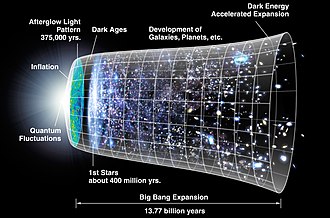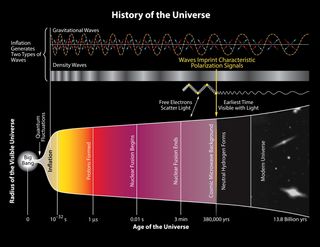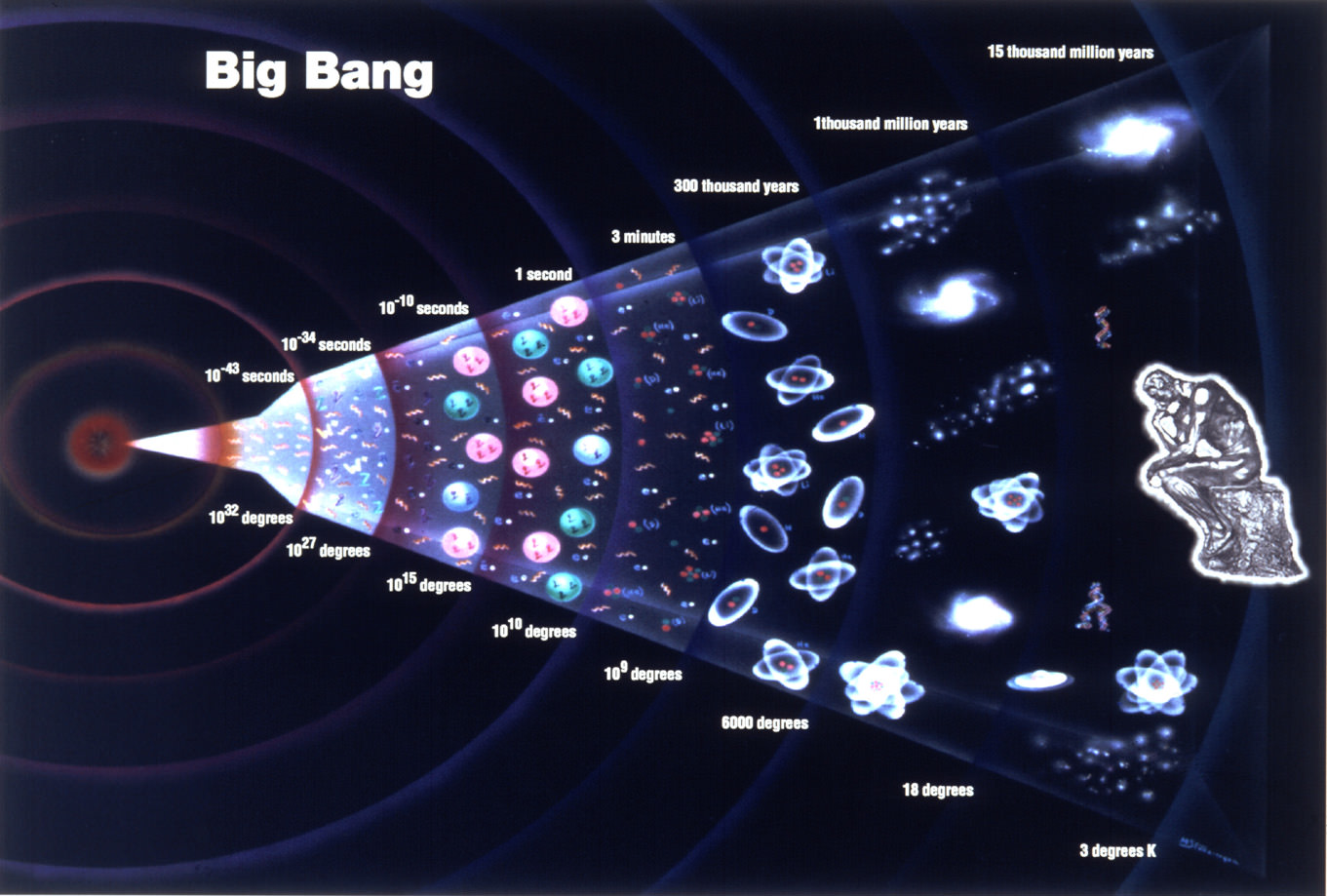God or Divine or Computer programmer or whosoever started the game of Leela and Reality, as we understand began:
The universe stirred (around 13 billion years ago), with every speck of its energy jammed into a very tiny point (in the Vedas called Hiranyagarbha or the creative egg). This extremely dense point exploded with unimaginable force, creating matter and propelling it outward to make the billions of galaxies of our vast universe. Astrophysicists dubbed this titanic explosion the Big Bang. While an explosion of a man- made bomb expands through air, the Big Bang did not expand through anything. That's because there was no space to expand through at the beginning of time. Rather, physicists believe the Big Bang created and stretched space itself, ever - expanding the universe.
Cosmologists believe the Big Bang flung energy in all directions at the speed of light (300,000,000 meters per second, a hundred thousand times faster than the H-bomb) and estimate that the temperature of the entire universe was 1000 trillion degrees Celsius at just a tiny fraction of a second after the explosion. Even the cores of the hottest stars in today's universe are much cooler than that.
But as the universe quickly expanded, the energy of the Big Bang became more and more "diluted" in space, causing the universe to cool. Rapid cooling allowed for matter as we know it to form in the universe and about one ten-thousandth of a second after the Big Bang, protons and neutrons formed, and within a few minutes these particles stuck together to form atomic nuclei, mostly hydrogen and helium. Hundreds of thousands of years later, electrons stuck to the nuclei to make complete atoms.
About a billion years after the Big Bang, gravity caused these atoms to gather in huge clouds of gas, forming collections of stars known as galaxies. Gravity is the force that pulls any objects with mass towards one another -- the same force, for example, that causes a ball thrown in the air to fall to the earth. Where do planets like earth come from? Over billions of years, stars "cook" hydrogen and helium atoms in their hot cores to make heavier elements like carbon and oxygen. Large stars explode over time, blasting these elements into space. This matter then condenses into the stars, planets, and satellites that make up solar systems like our own.
The universe stirred (around 13 billion years ago), with every speck of its energy jammed into a very tiny point (in the Vedas called Hiranyagarbha or the creative egg). This extremely dense point exploded with unimaginable force, creating matter and propelling it outward to make the billions of galaxies of our vast universe. Astrophysicists dubbed this titanic explosion the Big Bang. While an explosion of a man- made bomb expands through air, the Big Bang did not expand through anything. That's because there was no space to expand through at the beginning of time. Rather, physicists believe the Big Bang created and stretched space itself, ever - expanding the universe.
Cosmologists believe the Big Bang flung energy in all directions at the speed of light (300,000,000 meters per second, a hundred thousand times faster than the H-bomb) and estimate that the temperature of the entire universe was 1000 trillion degrees Celsius at just a tiny fraction of a second after the explosion. Even the cores of the hottest stars in today's universe are much cooler than that.
But as the universe quickly expanded, the energy of the Big Bang became more and more "diluted" in space, causing the universe to cool. Rapid cooling allowed for matter as we know it to form in the universe and about one ten-thousandth of a second after the Big Bang, protons and neutrons formed, and within a few minutes these particles stuck together to form atomic nuclei, mostly hydrogen and helium. Hundreds of thousands of years later, electrons stuck to the nuclei to make complete atoms.
About a billion years after the Big Bang, gravity caused these atoms to gather in huge clouds of gas, forming collections of stars known as galaxies. Gravity is the force that pulls any objects with mass towards one another -- the same force, for example, that causes a ball thrown in the air to fall to the earth. Where do planets like earth come from? Over billions of years, stars "cook" hydrogen and helium atoms in their hot cores to make heavier elements like carbon and oxygen. Large stars explode over time, blasting these elements into space. This matter then condenses into the stars, planets, and satellites that make up solar systems like our own.
While the Big Bang explains the process of creation of the Universe, is this the complete process or part of a cycle? Everything in existence is cyclic and impermanent passing through phases of creation, maintenance and obliteration. Some of the cycles we regularly encounter are the day and night cycles, the seasonal cycles, the tides, the waning and waxing of the moon, the creation and destruction of cells in the body etc.
In 1949, Richard Feymann, a physicist, proved the process of creation and destruction whereby an electron from the left collide with a positron coming from the right to mutually annihilate each other, while two photons are created which depart in opposite directions at the speed of light, thereby emitting a photon and went out of existence at that point. Or simply, that the original particle was destroyed and a new one created. Thereby proving that "every subatomic event is marked by the annihilation of the initial particle and the creation of a new one". Some of the subatomic collisions with the creation and destruction dance last less than a billionth of a second, which is its cyclical process.
In 1949, Richard Feymann, a physicist, proved the process of creation and destruction whereby an electron from the left collide with a positron coming from the right to mutually annihilate each other, while two photons are created which depart in opposite directions at the speed of light, thereby emitting a photon and went out of existence at that point. Or simply, that the original particle was destroyed and a new one created. Thereby proving that "every subatomic event is marked by the annihilation of the initial particle and the creation of a new one". Some of the subatomic collisions with the creation and destruction dance last less than a billionth of a second, which is its cyclical process.
The Infinite, out of which all existing things arise, has neither beginning nor end, the Universe is eternal. Carl Sagan, one of the greatest astronomers of the world has observed and acknowledged the fact that the Cosmos undergoes an immense, infinite number of deaths and rebirths through the cycle of creation, perpetuation and dissolution in a rhythmical pattern. Baffled by the immense intensity of the entire Cosmos, which he thought, was beyond the reach of any human mind, he said in his book “Cosmos" - "the size and age of the Cosmos are beyond ordinary human understanding. Lost somewhere between immensity and eternity is our tiny planetary home."
The universe is expanding now, but in its life span of billions of years, it will slow down, contract and annihilate to create one more time. There is nothing in this universe that is not cyclic and does not participate in this wonderful dance of destruction and creation. Hindu mythology points to a large scale projection of microcosmic scientific discoveries with symbolic deities like Brahma, Vishnu and Mahesh denoting the continuous cyclic dance of creation, sustenance and destruction and the Buddhist wheel of life symbolizing the unending process of birth, death and rebirth.


The universe is expanding now, but in its life span of billions of years, it will slow down, contract and annihilate to create one more time. There is nothing in this universe that is not cyclic and does not participate in this wonderful dance of destruction and creation. Hindu mythology points to a large scale projection of microcosmic scientific discoveries with symbolic deities like Brahma, Vishnu and Mahesh denoting the continuous cyclic dance of creation, sustenance and destruction and the Buddhist wheel of life symbolizing the unending process of birth, death and rebirth.



No comments:
Post a Comment